Fresh garlic (Allium sativum) is used in abundance in our kitchen, and is more than worthy of reserving some space for in our winter gardens.
Garlic can be planted in our area from late September through late November. We generally try to remember to plant just in time to ward off the vampires around Hallowe’en. Fortunately we managed to plant our garlic crop just before this last weekend’s storm, that gifted us with a much needed 3 inches of rain.
This year we’re planting two common softneck varieties of garlic. California Early, and California Late White, both of which thrive in our growing area.
California Late White has a stronger flavor than Early White, and is relatively heat tolerant. This variety is excellent for storage, and can be braided and stored for up to 8 months.
California Early White in comparison has a sweeter, and milder flavor, with less of the harsh bite typical of the Late White variety, and is a prolific producer, but doesn’t store quite as long as Late White.
Most importantly, we began by selecting a source for the seed garlic that is certified disease free. Although it is possible to plant commercially grown, store-bought, garlic cloves, there is absolutely no assurance that the garlic sold for home culinary use at the supermarket is free of diseases such as white rot (Sclerotium cepivorum).
It’s worth the extra effort, and minor incurred additional expense, to source seed garlic from a reputable grower. White rot is a disease that affects all species of Allium, not just garlic, so try to exclude it from your garden.
As a guide for ordering garlic, on average, a pound of seed garlic bulbs will be sufficient to plant a 25 foot row, spaced 4 inches between plants. Yield at harvest varies with the variety planted, but we expect approximately 10 pounds of yield for each one pound planted.
Preparing garlic for planting is simple. One garlic clove will produce a single bulb of garlic. The individual cloves from our seed garlic heads were separated, and inspected for both size, and quality. It is not necessary to remove the skin on each clove. It is important to discard any damaged or diseased cloves.
By planting only the healthiest, and largest garlic cloves, you are better assured of producing a sizeable, quality head of garlic.
With the cloves separated, the next step was preparing the beds for planting. The beds were turned over, and amended with finished compost to enhance moisture retention and drainage. Our hens of course helped us to turn over the beds.
Garlic prefers to grow in loose, well-drained soil. Generally speaking, looser soils will yield larger heads of garlic. Moisture retentive soils are important, as garlic does not like to completely dry out! A general purpose organic fertilizer was worked into the beds, and amended with organic bone meal, which slowly releases phosphorous to aid in bulb development.
With the beds raked, the individual cloves were planted, and covered with 2 inches of soil. It’s important, as with planting any bulb, to ensure that you’re planting right-side-up. Garlic cloves fortunately have an obvious blunted ‘root’ end, and a pointed ‘shoot’ end.
Note that gophers consider garlic to be haute cuisine!!!
If you have gophers, it’s worthwhile to protect your crop either with gopher baskets or sheet gopher wire. To protect our crop from overhead invasion, we also placed a floating row cover over the garlic as well. Once the soil has cooled, around Thanksgiving, we’ll add a layer of straw mulch to protect the garlic over winter, and then feed once with a balanced fertilizer in early spring.
If all goes well, and we succeed in keeping our gophers at bay, we hope to have a robust garlic crop ready for harvest sometime between mid-May and July next year.

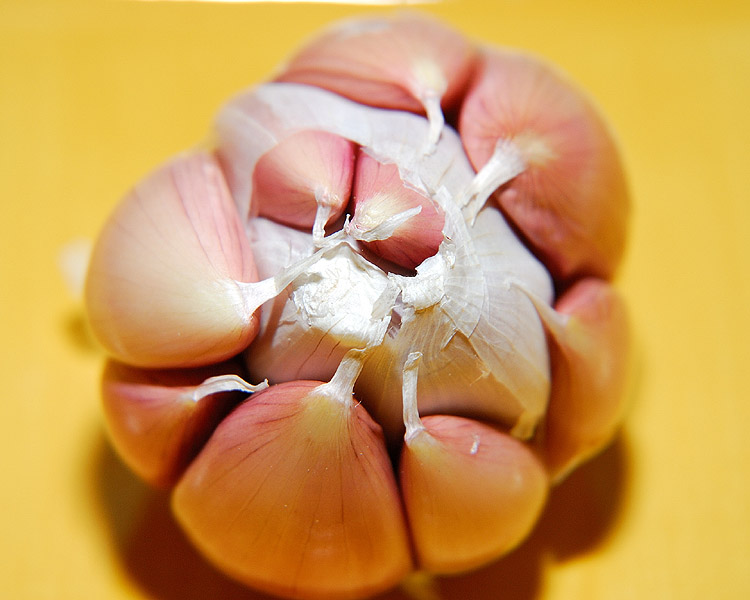
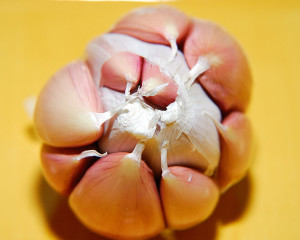
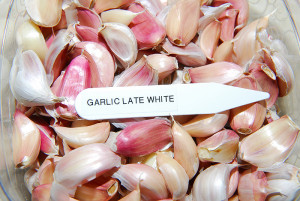
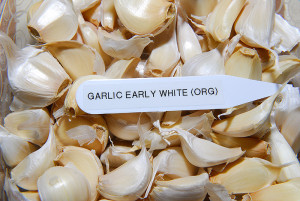
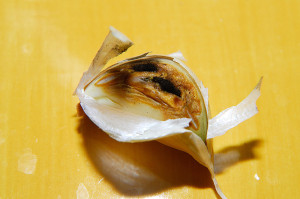
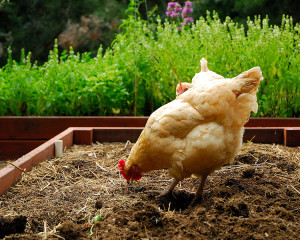
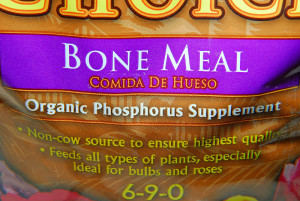
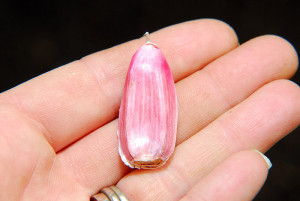
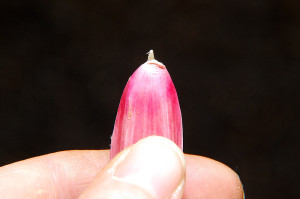
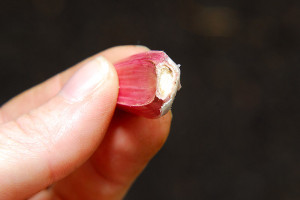









A wonderful post! I hope it does well for you!
Beautiful garlic! We grow all sorts, but I planted them together and lost track of the varieties so I don’t know what we have anymore.
Maybe this will help remind me to plant some this year. I’ve never had great luck with it, it just never gets very big. I hope you end up with lots of delicious garlic from your newly planted seeds.
Really nice post on garlic! And I planted ours yesterday. Garden center garlic it looked great. My second year with garlic only a few were sizable.
Great advices about garlic
I wanted to get some garlic for this season too, but I don’t have any more space, bummer.
I’ve always planted garlic in the early spring, but will now go right out and plant some – thanks for the tip. I like to plant it around my roses, hoping it will have a beneficial (or rather detrimental) effect on the aphids.
Eeek! Thanks for the reminder. I need to get some garlic in the ground.
Dear Clare, What timely advice you give here for I shall try to grow Garlic in a large pot as there is absolutely no room in the borders. I have never grown a vegetable, so I shall start with Garlic which I love.
Terrific post. I love cooking with the garlic scapes, as well. 🙂
Great instructions! I am always surprised at how much synchronicity there is between west coast/east coast gardening. I planted garlic a few days ago, too. It is one of my very favorite crops, partly because it is so critter-proof here… So I’m sorry about those stinkin’ gophers!
Now I feel the pressure to get that garlic planted! I bought some bulbs at a fruit market in Gilroy so I hope that are good enough. If the wind is right sometimes we smell the garlic fields of Gilroy at our house some 15-20 miles away!
Luckily we have not gophers with garlic clove shaped teeth. I must must plant garlic – last time we tried it was a flop on our hungry sandy soil. Thank you for the careful planting instructs will try again
The season up here was soooo cold and rainy that we pulled up our (elephant) garlic a month ago, dried it and then re-planted the cloves to give them another year to mature. It was like a “year off” for them… disappointing but while they were out of the ground we rototilled in lots of lovely rotted goat manure so I think next year the patch will be Club Med for garlic!! Here’s hoping! Thank you for commenting on the hardy kiwi – they are so very boy/girl dependent for pollination and I fear that ours are too far apart? They are twining towards each other and someday the bees may help us make the big connection. The fall kiwi foliage is so pretty that it covers the price of admission, in my view! I’ll put up some close-ups of the bare vines to show their aggressive twining habits. Cheers!! Bonnie
Clare, Gophers’ teeth are surely ferocious looking! Can you tell I am not a veggie garden, I went right for those teeth instead of commenting on your fantastic and easy to follow garlic growing instructions! gail
Can’t live without garlic, Clare, though have never once grown it. I admire all that you do, and so well. I must rely on the Farmer’s or local markets for my stash. The gopher teeth photo is hilarious to me (I’m a retired dental hygienist) but certainly not so fun for you. Good luck!
This is a great article. We just planted our garlic 2 weeks ago. It’s our first time so I am extremely excited and can’t wait to see them grow!
Fortunately my beds are all lines in wire mesh. That gopher photo is both excellent and horrifying. Those teeth and those powerful from paws sure can do a lot of damage in the garden, cinch traps notwithstanding.
I’ll be planting my garlic soon too!
Gophers…ggrrr. The first year I planted garlic, the gophers ate 98% of it! Some other writers have said that gophers don’t like garlic…wrong!
Where did you buy your garlic? I thought I’d go with Seed Saver’s Exchange, but I’m so late to the party that they’re totally sold out.
Feh.
We bought our seed garlic from Peaceful Valley:
http://www.groworganic.com/seasonal-items/seed-garlic.html
As garlic tends to be seasonally stocked by most distributors, it looks like they’re almost sold out too, but they do have some limited choices left.
Turtle Creek still has some limited stock too:
http://www.turtlecreektradingco.com/Seed-Garlic_c_1.html
Otherwise, try calling around to your garden centers near you. Our still had some seed garlic available last weekend. Good luck!